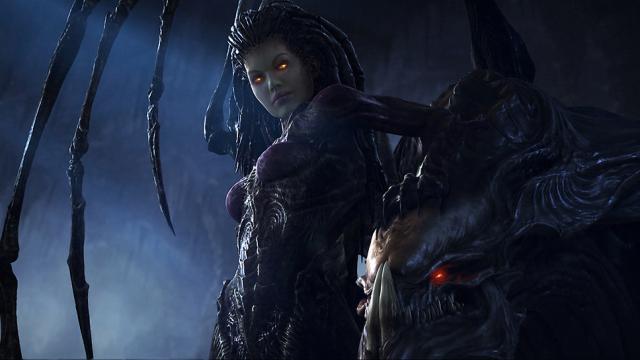One of StarCraft II’s most accomplished and well-known esports players is retiring from the game after two and half years at the very top of its competitive scene. Sasha Hostyn, or “Scarlett” to her many fans, recently revealed that she’s stepping away to try playing Dota 2 instead.
Scarlett explained her decision to step away from StarCraft II in an interview with The Guardian by saying that she wants to “try something else for a bit”. Like many top esports athletes, she’s very young (20 years old), and therefore considering what her future both in and outside of video games will look like (emphasis mine):
Scarlett seems uninterested in how her hobby is categorised. At 20, she has earned a good living from StarCraft II, winning $US111,000 in tournaments and thousands more while playing in a team league. She has become famous for her daring strategies on the digital pitch and also brave in her decision to reveal that she is transgender within a culture around video games that is often associated with misogyny.
“I plan to go to college next,” she says. “Maybe study Korean or computer science. I think e-sports players should think about higher education before they get too old. We don’t know how popular this will be in the future. If you focus 100 per cent on e-sports till you are 35 or so and it doesn’t continue to become mainstream, I think it could be harder in life later on.”
Once concern that plagues this, the first generation of so-called cyber athletes, is shared with their counterparts in physical sport: for how long will their minds and bodies be quick enough to enable top-level play. While e-sports are a sedentary pursuit, one’s action-per-minute rate (how many clicks of the mouse and keyboard one is able to make) is crucial to top-level StarCraft II play, as is a nimble mind. Scarlett, however, disagrees. “I think the decline is overstated,” she says. “People say after the age of 25 that you won’t be able to compete in e-sports any more. I don’t believe that’s true. In most other sports you are able to compete till you are 35-40. E-sports is even less of a physical activity. You can play till 40 easily; I don’t think this would affect how well you are able to play video games.”
Scarlett’s move will undoubtedly be seen by many esports followers and fans of both StarCraft II and Dota 2 as a highly symbolic act representing the former game’s decline in face of the latter’s ascent. This interpretation of events gets all the more dramatic when you consider the fact that Dota 2 originated from Defence of the Ancients, a game that started out way back when as a modified multiplayer map for the original StarCraft. If only Blizzard knew then that they were harbouring a game that would one day surpass its creator in popularity.
But let’s not get ahead of ourselves. Scarlett’s departure from the professional StarCraft II scene might be notable, but there’s no telling what will happen next. For all we know, she could go on to dominate Dota 2 just as triumphantly as she did StarCraft II. Or she could pull a Michael Jordan and come back to StarCraft II eventually. That’s a possibility she’s keeping open, judging by her comments on Twitter:
6.5k mmr by end of feb or i go back to sc2
— Scarlett (@AcerScarlett) January 24, 2015
The most interesting part of Scarlett’s transition will be seeing how she adapts to team play in Dota 2, which is a five-vs.-five game. StarCraft II — at least the high-level competitive game Scarlett participated in — is one-vs.-one. Despite their myriad similarities, then, each game requires different skills. Scarlett broached this topic in her Guardian interview (emphasis mine again):
Dota 2, another American game, is played with two teams of five players and each player has a clearly defined role. For Scarlett, who has spent her career answering only to herself, the idea of working alongside other players is daunting. “Playing with strangers is always a challenge,” she says. “But I’m going to start looking for people who share my view and approach to the game soon. There can’t be conflict else you won’t be able to play well.” Scarlett’s plan to switch e-sports is unprecedented, she says. “If I can be good at both it will be something nobody has really done before.” But while both games are vastly different, they share elements that Scarlett considers essential for professional play. “Both games are extremely well-balanced,” she says. “More importantly, there are lots of ways in which, if you are better than someone else, you can create a lead. That’s crucial in high-level competitive play.”
I wonder if Heroes of the Storm will be able to coax her back to the Blizzard fold eventually. Until then, Scarlett will be a key player to keep an eye on in Dota 2’s competitive scene.

Comments
One response to “One Of StarCraft’s Biggest Players Is Leaving For Dota 2”
Ermmm… maybe this is just the cynical side in me.. but those bolds are making way too much fuss over jumping games on that interview. “Unprecedented?”
A fair few of SC2 eSports players have swapped to DotA2 and LOL. It’s nothing new to be honest =/
They’re different skill sets. Starcraft is big picture (mostly macro, with occasional high-level micro) with composition reads. MOBAs is more about team micro co-ordination. Every now and then, someone like MarineKing switches to LoL and discovers his skills just don’t transfer.
Well, Scarlett is very far from being one of SC2s’ (or any gaming scene) biggest contenders…
I would probably akin her to being an extra, on a TV show, that currently nobody watches…
She’s actually one of the most skilled and successful foreign players, playing in Korean tournaments like starleague.